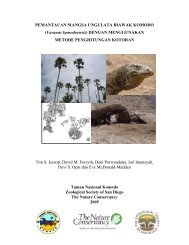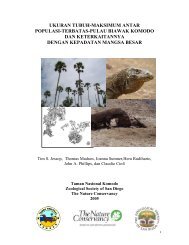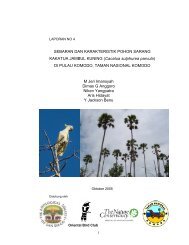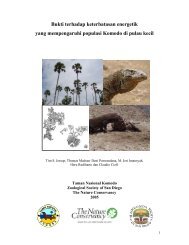Sustainable Financing of MPAs - Komodo National Park
Sustainable Financing of MPAs - Komodo National Park
Sustainable Financing of MPAs - Komodo National Park
You also want an ePaper? Increase the reach of your titles
YUMPU automatically turns print PDFs into web optimized ePapers that Google loves.
the local communities on mariculture (aquaculture in the sea) and seaweed culture 9 . In<br />
addition to this, villagers have expressed their interest to become <strong>Park</strong> staff and to receive<br />
training and assistance for the development business tourism skills or handicraft, for example<br />
(Subijanto 2002). According to the UNEP Regional Office for Asia and the Pacific, <strong>Komodo</strong><br />
<strong>National</strong> <strong>Park</strong> assisted by the Ministry <strong>of</strong> Forestry have innovative training programs for<br />
residents and park staff (UNEP 2002). Training and assistance, among others, are also going<br />
to take place under the collaborative management and the tourism concession as part <strong>of</strong> the<br />
capacity building component (World Bank 2001).<br />
3.3.5 Political<br />
The government is undergoing a decentralization process, which allows the new financial<br />
and management mechanisms to take place (TNC 2005). Under this development,<br />
conservation responsibilities will rely more on local authorities and would require more<br />
collaboration with the local governments (World Bank 2001). It could also be said that the<br />
economic crisis has led to an adaptation process where the government is open to experiment<br />
with new management approaches and new financial mechanisms. This gives an opportunity<br />
to plan for the future, even though there are still some legal and political reforms to be done.<br />
(Subijanto 2002) Nevertheless, it is almost impossible to have a financial structure that is<br />
totally independent <strong>of</strong> political changes, since tourism revenues are affected by instability and<br />
government contribution relies on its economic situation (World Bank 2001).<br />
3.3.6 Environmental<br />
The main objective from the collaborative management, the joint venture, the tourism<br />
concession and the GEF grant is to protect and preserve the natural resources and biodiversity<br />
<strong>of</strong> the park (TNC 2005; Subijanto 2002; Djohani 2005; World Bank 2002). Another main<br />
target is to decline the destructive fishing practices and poaching incidents. As part <strong>of</strong> the<br />
tourism concession, revenues would also be channeled to research and development <strong>of</strong><br />
sustainable methods <strong>of</strong> marine resource use and carrying capacity. This is also related to the<br />
possible effects <strong>of</strong> the new financing mechanisms on the environment. Studies on carrying<br />
capacity as well as environmental impact assessments have been carried out and some are still<br />
planned, to be sure that the increment <strong>of</strong> infrastructure and visitors would not affect the<br />
conservation and protection objectives. This holds as well for productive activities that are<br />
carried out as part <strong>of</strong> the promotion <strong>of</strong> sustainable livelihoods. (Subijanto 2002; World Bank<br />
2001)<br />
9 USAID also support pilot seaweed cultivation projects involving 8 communities in and around <strong>Komodo</strong><br />
<strong>National</strong> <strong>Park</strong>. (USAID 2005)<br />
20






